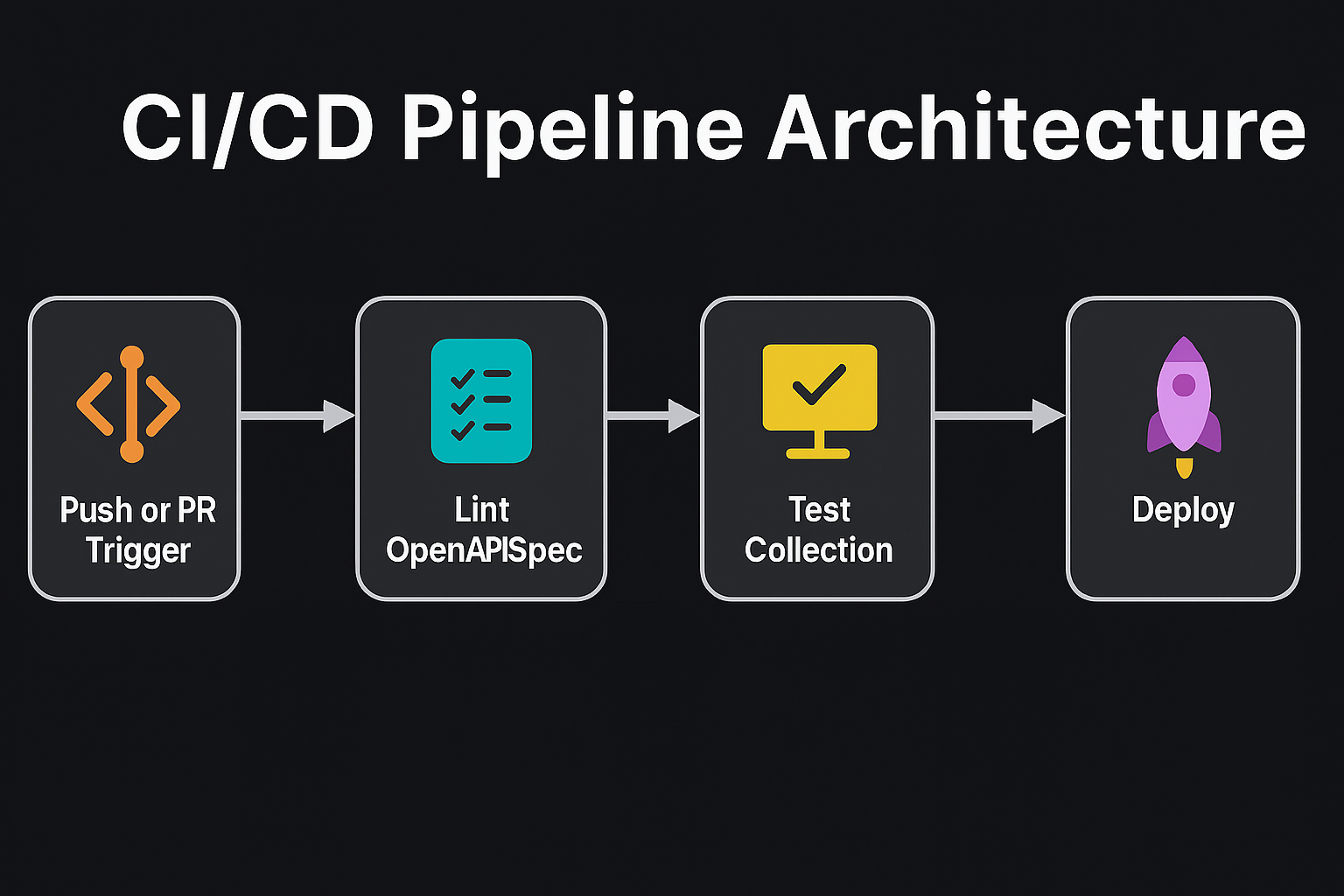🛠️ CI/CD Pipelines for API Integration
The modern API lifecycle demands both agility and precision. Developers are shipping faster than ever, and without guardrails, it's easy for critical mistakes to slip through. Continuous Integration and Continuous Deployment (CI/CD) practices allow you to automate checks, validate API contracts, and test behavior every time your code changes. It’s not just a toolchain upgrade, it’s a development philosophy. Within the context of API development, CI/CD ensures your OpenAPI spec
is continuously tested, aligned, and always deployable.If you've followed our Quick-Start Checklist and Environment Setup, you’re already equipped with the foundational tools: Spectral
, Newman, and Git. Now, it's time to put them into a production-grade pipeline that safeguards every commit and enables confident deployments.🤝 Why CI/CD Matters for APIs
Imagine shipping software without a final spell-check every new feature, fix, or documentation tweak could introduce silent breakage. This is exactly the risk that CI/CD eliminates. CI/CD transforms your development process into a safety-first pipeline, where each change is scanned, validated, and tested automatically.
In API-centric systems, that means checking every change to your OpenAPI spec
before it's merged. It means testing those changes against mock or live endpoints. It means catching malformed responses, schema violations, and version drift before customers feel them. With lightweight CI tools like GitHub Actions or GitLab CI, even solo developers can implement enterprise-level protection.📊 CI/CD Pipeline Architecture

This flowchart visualizes the key stages of a modern API CI/CD pipeline. The flow begins with a Push or PR Trigger, which initiates sequential validation: OpenAPI linting, YAML validation, Postman collection testing, and finally, a controlled deployment to staging or production.
Think of this like an airport runway: every plane (your API change) needs to pass safety checks (linting), function checks (tests), and environmental compatibility (infrastructure previews) before it can take off. This diagram ensures developers understand the pipeline’s logic and critical touchpoints.
🔧 Linting Your Spec with GitHub Actions
name: Lint OpenAPI Spec
on:
push:
branches: [main]
pull_request:
jobs:
lint:
runs-on: ubuntu-latest
steps:
- uses: actions/checkout@v3
- name: Install Spectral
run: npm install -g @stoplight/spectral-cli
- name: Lint openapi.yaml
run: spectral lint openapi.yaml
Figure 2. YAML Workflow
This YAML workflow defines a GitHub Actions
job that runs Spectral against your OpenAPI spec on every push or pull request. Think of Spectral as the “grammar checker” for your API contract, it ensures field types match, descriptions are required, and response codes align with best practices.This stage acts as your API’s quality gate. If Spectral fails, the change is blocked, protecting your downstream consumers and internal tools from surprises.
🧰 Testing API Collections with Newman
name: Run Postman Tests
on:
push:
branches: [main]
jobs:
postman-tests:
runs-on: ubuntu-latest
steps:
- uses: actions/checkout@v3
- name: Install Newman
run: npm install -g newman
- name: Run Collection
run: newman run postman/collection.json -e postman/env.json
Figure 3. Running Postman Tests using YAML
Once your spec is valid, it’s time to validate behavior. Newman executes your Postman collection
in CI, verifying that your actual responses match expectations. Are you returning a 200 when you should? Are all fields populated as documented? Newman ensures you’re not just compliant, but consistent.Combined with linting, this setup forms the backbone of API contract testing. Your CI now guards against both syntactic issues and behavioral regressions.
🏋️ Choosing the Right CI Tool
GitHub Actions
Strength: Native to GitHub, easy YAML setup, ideal for small to mid-size APIs.
Example: Runs Spectral + Newman tests on push to main.
GitLab CI
Strength: Great for full-stack DevOps pipelines with visual config support.
Example: Executes test matrix using .gitlab-ci.yml.
CircleCI
Strength: Parallel job support and caching. Great for fast, multi-env testing.
Example: Validates across staging and production branches.
Jenkins
Strength: Highly customizable for enterprise APIs with advanced needs.
Example: Postman test dashboards + OpenAPI contract gates.
Bitbucket Pipelines
Strength: Simple CI for Bitbucket users. YAML syntax mirrors GitHub Actions.
Example: Executes Spectral on merge into release branches.
Choosing a CI provider can feel like choosing a cloud, there’s no “best,” only “best for your use case.” If your team lives in GitHub, GitHub Actions will feel native. Running Kubernetes clusters? GitLab CI might align better. Need full control and custom dashboards? Jenkins is unbeatable. Building with a startup mindset? CircleCI or Bitbucket Pipelines will get you shipping fast.
What matters most is compatibility with YAML-based pipelines, support for your language/runtime, and integration with tools like Spectral and Newman. All five options above meet these needs. The animated comparison above helps you visually weigh tradeoffs.
🔄 What You've Achieved
You’ve just implemented a self-healing, automated CI pipeline for your API. From static linting to live behavior validation, every step is now continuously enforced. This protects your team, your product, and your consumers from surprises, and lets you scale with confidence.
If you started from our Quickstart and Environment Setup sections, this milestone completes the core lifecycle for managing API changes. From here on, every OpenAPI change you make will be validated, tested, and approved before deployment. That’s the definition of robust.
🗓️ Next: OpenAPI Spec Design Philosophy
In the next section, we’ll zoom out. We’ll stop looking at automation and start thinking about spec architecture. How do you design an OpenAPI spec that scales across teams, versions, and endpoints? How do you modularize your definitions, reuse common responses, and avoid duplication?
You’ll learn the principles of scalable spec design, including the use of components, naming patterns, and grouping strategies. If CI/CD was your structure, the next step is your blueprint.